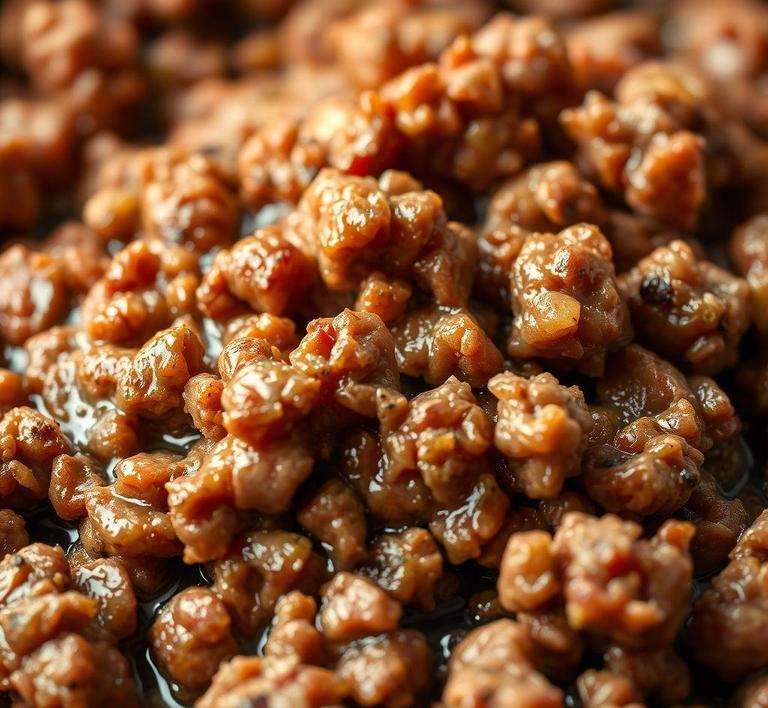Wondering if it’s safe to refreeze ground turkey? You’re not alone! Many of us buy extra turkey to save for later, but when you don’t get to it in time, the dilemma arises. Refreezing ground turkey can be a bit tricky, but with the right knowledge, it can be done safely without compromising its quality. In this guide, we’ll walk you through the best practices for refreezing ground turkey, what to look out for, and how to store it to make sure your turkey stays fresh and delicious for your next meal. Let’s dive into how to handle it right!
Can You Refreeze Ground Turkey?

Refreezing ground turkey is a topic that sparks some debate in both home kitchens and professional food safety circles. The general answer is yes, you can refreeze ground turkey, but there are important nuances and guidelines to consider to ensure both the safety and quality of the meat are maintained.
When you freeze ground turkey, the water content within the meat forms ice crystals. These ice crystals, while harmless in themselves, can rupture the structure of the meat, leading to changes in texture when thawed. The situation becomes more complex when you thaw the turkey and then attempt to refreeze it. The process of thawing causes bacterial activity to increase, particularly when the meat sits at temperatures between 40°F (4°C) and 140°F (60°C), commonly known as the ‘danger zone’ for bacterial growth. If ground turkey has been left in this temperature range for too long, refreezing could result in potential foodborne illness.
However, if the ground turkey has been thawed safely in the refrigerator (never on the counter or at room temperature), it can be safely refrozen, as long as it hasn’t been left in the danger zone for an extended period. The quality of the meat may decrease with each freezing and thawing cycle, but if done properly, the safety risks are minimal.
How To Refreeze Ground Turkey?
Refreezing ground turkey requires careful attention to food safety protocols. Here’s a step-by-step guide to help you do it properly:
- Thaw Properly: If you’ve frozen ground turkey and are now looking to thaw it, the best method is in the refrigerator. Place the turkey in a bowl or dish to catch any potential drips and allow it to thaw slowly, keeping it at a safe temperature (below 40°F). This can take anywhere from 12 to 24 hours, depending on the amount of meat.
- Never Thaw at Room Temperature: Never leave ground turkey on the counter to thaw. Room temperature allows harmful bacteria to multiply rapidly, putting the safety of the meat at risk. If you’ve accidentally left turkey at room temperature for more than two hours, discard it to avoid the risk of foodborne illness.
- Cook Before Refreezing: If you’ve thawed the ground turkey and decided you’re not going to use it immediately, it’s often best to cook it before refreezing. Cooking the turkey will kill any bacteria that may have started to grow during the thawing process, making it safer for refreezing. Simply cook it to a safe internal temperature of 165°F (74°C) before storing it again in the freezer.
- Package It Correctly: Once the cooked or raw turkey is ready for refreezing, it’s important to package it properly. Use airtight freezer-safe bags or containers to prevent freezer burn, which happens when air comes into contact with the meat. If using bags, try to squeeze out as much air as possible before sealing. If you’re refreezing cooked ground turkey, consider dividing it into smaller portions for easy defrosting in the future.
- Label and Date: Always label the package with the date it was refrozen. This helps keep track of how long it’s been in the freezer and ensures you use it within the recommended storage times.
Quality Impact
Refreezing ground turkey can have an impact on its quality, both in terms of texture and flavor. The freezing process itself causes ice crystals to form within the meat, which can rupture cells and disrupt the muscle fibers, leading to a slightly mushier texture upon thawing. With each cycle of freezing and thawing, the quality can degrade further.
Here’s how refreezing may affect the quality of ground turkey:
- Texture: The repeated freezing and thawing process affects the structure of the turkey. As ice crystals form and break apart the muscle fibers, the texture of the meat can become more watery, crumbly, and less firm. This may not be an issue if you’re cooking the turkey into a dish like chili, meatballs, or tacos, but it could be noticeable if you’re using the ground turkey in a dish where the texture is more important.
- Moisture Loss: With every freezing and thawing cycle, some moisture is lost from the meat. This can result in a dry product when cooked, which could alter the overall flavor and mouthfeel of the ground turkey. If you’ve cooked the turkey before refreezing, the loss of moisture will be more noticeable since the meat is already cooked and may dry out further during reheating.
- Flavor Changes: Ground turkey tends to absorb flavors from its environment, especially if not tightly sealed during freezing. Over time, the flavor may become less fresh, with some freezer burn potentially affecting the taste. Freezer burn occurs when air reaches the meat and dries it out, leading to off flavors and a change in texture. The longer you store the ground turkey, the more likely this is to happen, although proper packaging can help minimize this issue.
- Nutritional Loss: Nutritionally, freezing does not cause significant losses of vitamins or minerals in meat. However, if the meat is exposed to oxygen due to improper packaging, some nutrients like Vitamin E could degrade over time. These changes are relatively minimal, but they do compound when the meat is refrozen multiple times.
While refreezing ground turkey is safe, it requires caution and proper handling to ensure both the safety and the best possible quality of the meat. The key takeaway is that ground turkey should be thawed in the refrigerator, cooked if necessary, and then properly repackaged before being refrozen.
While there are some quality impacts to consider-such as changes in texture, moisture, and flavor-the safety risks associated with refreezing are minimal if done properly. To preserve the best taste and texture, it’s advisable to only refreeze ground turkey once and to avoid leaving it in the "danger zone" for extended periods of time. By following these guidelines, you can safely extend the shelf life of your ground turkey while still enjoying it in a variety of dishes.
Is It Safe To Refreeze Ground Turkey?
Refreezing ground turkey can be a bit of a gray area, as it depends on several factors such as how it was initially thawed, the duration of time it spent in the fridge, and whether or not it has been cooked. The safety of refreezing ground turkey is largely rooted in the USDA’s food safety guidelines, which emphasize the importance of preventing bacterial growth.
When ground turkey is frozen, thawed, and then refrozen, there is a risk of bacteria developing, particularly Salmonella and Campylobacter-two pathogens that are commonly found in raw poultry. This risk arises because when meat is thawed, its temperature rises to a point where bacteria can begin to multiply. If ground turkey is not cooked thoroughly before being refrozen, these bacteria can survive, potentially leading to foodborne illness.
That said, if the ground turkey has been thawed properly-either in the refrigerator, microwave, or under cold running water-and then cooked to an internal temperature of 165°F (73.8°C), it can be safely refrozen. Cooking kills the bacteria that may have developed during the thawing process, significantly reducing the risk of contamination when refrozen. However, it is important to note that while refreezing cooked turkey is generally safe, it may affect its texture and flavor due to moisture loss during the freezing and thawing process.
In summary, yes, it can be safe to refreeze ground turkey under certain conditions, but you must ensure that it is either cooked thoroughly or still within safe time frames for refrigeration and freezing. Always handle meat with caution to prevent contamination, and use a food thermometer to be sure it reaches the proper cooking temperature.
Signs That Ground Turkey Should Not Be Refrozen
While it’s possible to refreeze ground turkey safely, there are several signs to watch out for that indicate your turkey should never be refrozen, as it could be dangerous to eat.
- Off-Putting Odor: One of the most common indicators that your ground turkey should not be refrozen is a foul or sour smell. Raw turkey should have a very mild scent; if it smells rancid or unpleasant, it is a sign that bacteria have proliferated and the meat has spoiled. Refreezing spoiled meat will not make it safe to eat, and the bacteria may still cause foodborne illness.
- Discoloration: Fresh ground turkey is usually light pink with some visible white fat. If the turkey turns gray, brown, or green, it’s a major warning sign. Discoloration can indicate that the meat has begun to spoil due to exposure to air or improper storage. When you see any change in color, it’s better to err on the side of caution and discard the meat instead of trying to refreeze it.
- Slimy or Sticky Texture: Fresh turkey should feel moist but not slimy or sticky. If the ground turkey feels slippery to the touch, it has likely started to decompose and should not be refrozen. This is another sign of bacterial growth, which can be harmful if consumed, even after cooking.
- Improper Thawing: If the turkey was thawed improperly, such as being left out at room temperature for several hours, it should not be refrozen. Bacteria multiply rapidly at room temperature, and once they have reached unsafe levels, cooking or refreezing will not eliminate the risk of foodborne illness.
- Long Storage Time: If the turkey has been sitting in the refrigerator for too long (usually beyond 1-2 days for raw turkey), it’s not advisable to refreeze it. The general guideline is to cook or freeze turkey within 1-2 days of purchase to ensure freshness and safety.
Common Refreezing Mistakes
Refreezing ground turkey can be a tricky process, and there are a few common mistakes that people often make, leading to compromised food safety and quality. Here are the most frequent missteps to avoid:
- Thawing at Room Temperature: One of the biggest mistakes is thawing turkey at room temperature, which is a prime environment for bacteria to grow. Ground turkey should always be thawed in the refrigerator, under cold running water, or in the microwave if it’s going to be cooked immediately. Room temperature thawing should be avoided at all costs.
- Refreezing Without Cooking: Refreezing raw ground turkey that has been thawed is risky because bacteria can proliferate during the thawing process. If you plan to refreeze, make sure to cook the turkey to the proper temperature before doing so. Cooking kills harmful bacteria and makes the meat safe to freeze again.
- Refreezing Multiple Times: Each cycle of freezing and thawing affects the texture and flavor of the turkey. The more times it is frozen and thawed, the worse the quality becomes, as moisture loss occurs during each freeze-thaw cycle. Additionally, each thawing period provides another opportunity for bacteria to multiply. Try to limit how often you freeze and thaw ground turkey.
- Freezing Meat in Large Clumps: Freezing large quantities of ground turkey together in one large clump makes it difficult to thaw the meat evenly and can lead to parts remaining in the danger zone for bacteria growth. It’s better to portion out the meat into smaller packages before freezing, allowing for faster and safer thawing later.
- Not Labeling Frozen Meat: Not labeling your ground turkey with the date it was frozen can lead to confusion when trying to determine its freshness. Over time, frozen meat can lose quality, and you may end up refreezing it after it has already been stored for too long, risking contamination or spoilage.
Tips And Tricks
If you plan on refreezing ground turkey, here are some useful tips and tricks to make the process safer and more efficient:
- Use Vacuum Sealing: If you’re refreezing ground turkey, vacuum sealing is one of the best ways to preserve its quality. The vacuum-sealed bags eliminate air exposure, preventing freezer burn and maintaining the texture of the meat. This also extends its shelf life in the freezer.
- Portion Before Freezing: Portioning the ground turkey into smaller amounts before freezing helps you thaw only what you need, minimizing waste. It also ensures that the meat thaws evenly, reducing the risk of bacteria growth.
- Double Wrap for Protection: If you don’t have a vacuum sealer, double wrap your turkey. First, wrap it in plastic wrap or parchment paper, then place it in an airtight freezer bag. This helps prevent freezer burn and helps the turkey maintain its quality for longer.
- Use Freezer-Safe Containers: If you are storing the turkey in containers, make sure they are designed for freezing. Regular plastic bags or containers might allow air and moisture to seep in, leading to freezer burn or deterioration.
- Set a Reminder: It’s easy to forget how long meat has been sitting in the freezer. Set a reminder on your phone or mark the packaging with the date so you know when it’s time to use or discard the turkey.
- Freeze Quickly: When freezing ground turkey, the faster it freezes, the better its texture will be. Make sure the freezer is set to a cold enough temperature (-18°C or 0°F or lower) to freeze the turkey quickly and prevent ice crystals from forming, which can damage the meat’s cells.
Conclusion
Refreezing ground turkey can be safe, but it comes with a few risks and considerations. It’s crucial to thaw the meat correctly, avoid leaving it at room temperature for extended periods, and cook it thoroughly before refreezing. Discarding turkey that shows signs of spoilage, such as an off smell, discoloration, or sliminess, is vital to avoid foodborne illness.
By following proper thawing, cooking, and storage methods, you can ensure that your ground turkey remains safe to eat and retains its flavor and texture after being refrozen. With a little knowledge and preparation, refreezing can be a convenient way to make sure that no food goes to waste while keeping your meals safe and delicious.


